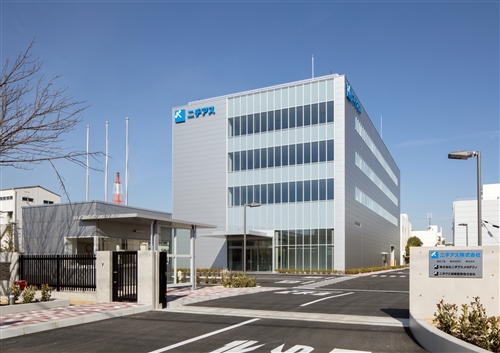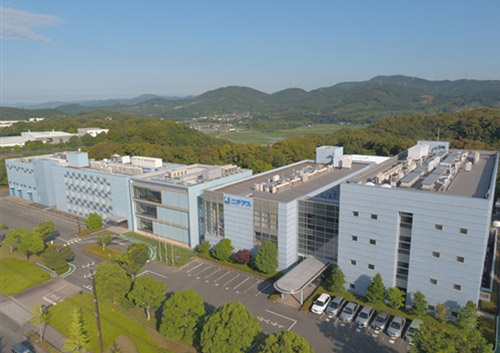Research & Development
The research and development activities of the NICHIAS Group are undertaken under a framework consisting of the two research laboratories of the Tsurumi Research Laboratory ((Yokohama City, Kanagawa Prefecture) and Hamamatsu Research Laboratory (Hamamatsu City, Shizuoka Prefecture) and the technical centers of each division.
In implementing research and development, the technical centers of each division are responsible for developing products and construction methods in close alignment with NICHIAS’ customers, and the Research & Development Division is responsible for carrying out fundamental research and developing future technologies. At the same time, the Business Division and Research & Development Division work together in a flexible manner to tackle development issues, and in the case of manufacturing issues, strive to liaise smoothly with the Engineering Division, plants, and manufacturing subsidiaries.The Research & Development Division of NICHIAS Corporation has a research and development department that facilitates fundamental research and the development of future technologies, a department specializing in heat measuring, refractory technologies, and CAE, and a department specializing in chemical analysis. The Research & Development Division supports the research and development of NICHIAS’ “Insulation and Protection” technologies.

Tsurumi Research Laboratory

Hamamatsu Research Laboratory
Main Initiatives
Let us introduce some representative actions regarding the development of “TATSU-TAMOTSU (Insulation and Protection)” technologies.
1. Contribution to the shift to renewable energy
In Japan, where suitable areas for renewable energy production are limited, renewable energy needs to be converted into some kind of energy carrier for storage and transportation. Carriers suitable for importing energy from overseas include liquid nitrogen and ammonia. Liquefied hydrogen is an energy carrier that excels at volumetric efficiency, etc., but liquefaction requires cryogenic temperatures of -253°C. Here, we think there is an area where the NICHIAS Group can contribute and deal with the establishment of evaluation and design technologies for insulation and other materials. So far, in the area of high-temperature insulation, the NICHIAS Group has contributed to society not only in development but also in basic technologies, such as the establishment of ISO standards for thermophysical property measurements. We will master the “protection” technologies that people rely on in extremely lowtemperature fields as well.
2. Contribution to information communication and the semiconductor industry
The increase in the speed of information communication equipment knows no bounds. Fluororesin is a prospectivematerial for the next-generation 5G/6G substrate due to its low transmission loss. However, fluororesin has weaknesses in a high thermal expansion coefficient, poor adhesion, and difficulty in compositing with copper foil and other circuit materials. We now have a prospect for technical measures to overcome thermal expansion and adhesion problems, and we are accelerating the research and development.
In the semiconductor industry, there are increasing requests for manufacturing device components in response to the technologies for miniaturization of semiconductor elements and conversion to 3D. The NICHIAS Group has been engaged in the development of fluorinated rubbers with excellent heat and corrosion resistance to refine our cross-linking technology. We are continuously working on rubber cross-linking technologies that realize higher performance.
3. Contribution to carbon neutrality
Thermal insulation technologies directly respond to carbon neutrality by saving energy from heat-using equipment. We are engaged in (1) development of technologies to improve the performance and user-friendliness of thermal insulation and cryogenic insulation, (2) development of thermal diagnosis technologies that visualize the necessity of thermal insulation and cold retention, and other efforts.
Future Challenges and Outlook
To accelerate the sophistication of material technologies, we started to use a high-brightness synchrotron radiation facility, NanoTerasu, which was set up at Tohoku University this April. NanoTerasu is the world’s most advanced X-ray facility for materials analysis. It was established by the Japanese government to strengthen the country’s research capabilities and increase productivity. In addition to the capability of NanoTerasu, we also endorsed the mechanisms of “coalition” that produce results in partnership between industry and academia. The NICHIAS Group joined it in March 2024. The NICHIAS Group has used various evaluation facilities, including devices using X-rays to analyze materials. NanoTerasu will be a powerful addition to our tools. We will further accelerate the development of our materials and new products.
The evolution of research and development by digital transformation is also an important issue. Consolidating the research and development information by using the informationmanagement and sharing tools, we try to streamline the process. We also pay attention to Materials Informatics (MI) and examine how to use it in a NICHIAS Group’s way. There may be excellent information analysis tools and AI technologies. However, whether to use it depends on people’s ability. In the Research Laboratory, we are committed to developing not only human resources that can utilize information technologies but also those who can use “TATSU-TAMOTSU (Insulation and Protection)” technologies. We continue to provide technical human resources in the NICHIAS Group, which will help us offer products and services that help people in society.

